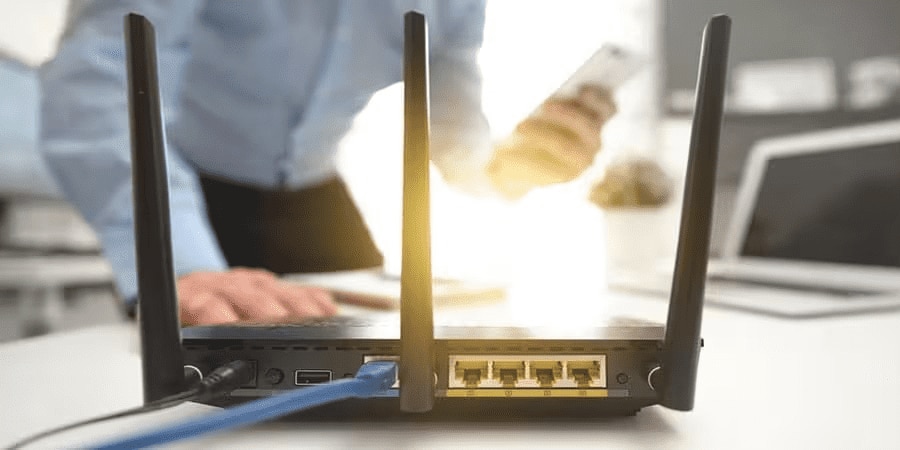A weak Wi-Fi signal can be incredibly frustrating, whether you’re working from home, streaming movies, or gaming online. This comprehensive guide will show you exactly how to boost your Wi-Fi signal and improve your wireless connection throughout your house. By following these proven methods, you can enhance your Wi-Fi coverage, eliminate dead zones, and maximize your internet speed.
Understanding What Affects Your Wi-Fi Signal
Before attempting to boost your Wi-Fi signal, it’s important to understand what causes poor wireless performance in your home. Several key factors can significantly impact your signal strength:
Common Signal Obstacles:
- Walls (especially concrete and metal)
- Floors and ceilings
- Large metal furniture and appliances
- Mirrors with metallic coating
- Electronic devices
Signal interference often comes from everyday household devices operating on the 2.4GHz frequency band, including microwave ovens, cordless phones, and baby monitors. Bluetooth devices and neighboring Wi-Fi networks can also compete for bandwidth, potentially degrading your network performance.
Distance naturally weakens your Wi-Fi signal, with each wall or obstacle causing additional signal loss. Upper floors and corner rooms typically experience poorer reception, while outdoor areas may have limited coverage due to building materials and distance from the router.
15 Ways to Boost Your Wi-Fi Signal
1. Optimize Your Router’s Location
The single most effective way to boost your Wi-Fi signal is proper router placement. Position your router in a central location within your house, elevating it off the floor to chest height or higher. Avoid placing it near metal objects, concrete walls, or electronic devices that might interfere with the signal.
Key placement guidelines:
- Central house location
- Elevated position
- Away from metal objects
- Clear of dense walls
- Outside of cabinets
2. Update Your Router’s Firmware
Regular firmware updates can significantly improve your wireless network performance. High-performance options like the
HPE Instant On AP32 with tri-band Wi-Fi 6 support require regular updates to maintain optimal performance. Check
HP’s networking solutions for the latest enterprise-grade hardware.
To update your firmware:
- Access your router’s administrator interface
- Navigate to the firmware section
- Check for available updates
- Install updates if available
- Restart your router
3. Optimize Wi-Fi Channels
Channel congestion can severely impact your Wi-Fi signal strength. Use a Wi-Fi analyzer app to identify the least congested channels in your area. For 2.4GHz networks, stick to channels 1, 6, or 11 to avoid overlap. 5GHz networks offer more channel options and typically experience less interference.
4. Upgrade to Wi-Fi 6 or Wi-Fi 6E
Modern Wi-Fi standards offer significant improvements in speed and coverage. For indoor spaces, the
HPE Instant On AP25 provides excellent dual-band coverage, while the weatherproof
HPE Instant On AP27 extends your network to outdoor areas. For optimal workspace connectivity, pair with
HP business laptops and accessories.
Benefits of upgrading include:
- Faster connection speeds
- Better device handling
- Improved range
- Reduced interference
- Future-proof network
5. Implement Mesh Networking
A mesh network can dramatically improve your Wi-Fi coverage by creating a seamless network of connected nodes throughout your home. The system automatically routes traffic through the fastest path and can easily scale by adding more nodes.
For optimal mesh performance:
- Place the main node centrally
- Position additional nodes within range
- Use wired backhaul when possible
- Maintain node line of sight
- Monitor performance regularly
6. Use a Wi-Fi Range Extender
Range extenders can help amplify your Wi-Fi signal in specific areas where coverage is weak. Place the extender halfway between your router and the dead zone for best results. Use the same network name and password for seamless roaming between your main network and the extended network.
7. Optimize Router Settings
Fine-tune your router’s settings by adjusting:
- Transmit power
- Band steering
- Quality of Service (QoS)
- Channel width
- Security protocols
8. Utilize Ethernet Connections
Reduce wireless congestion by connecting stationary devices directly to your router via ethernet cables. This provides faster, more stable connections and frees up wireless bandwidth for mobile devices. For a complete workspace setup, explore
HP monitors and displays with built-in ethernet connectivity.
9. Upgrade Router Antennas
Consider replacing your router’s stock antennas with high-gain alternatives. Directional antennas can focus signal strength where needed, while high-gain omnidirectional antennas can improve overall coverage.
10. Enable Quality of Service (QoS)
QoS settings allow you to prioritize important traffic like video calls and gaming while limiting bandwidth for less critical tasks. Configure QoS based on your household’s specific needs and usage patterns.
11. Consider Powerline Adapters
Powerline adapters use your home’s electrical wiring to extend your network, bypassing Wi-Fi obstacles entirely. These work particularly well for reaching distant rooms or floors where Wi-Fi signals struggle to penetrate.
12. Monitor Network Traffic
Regular network monitoring helps identify and resolve performance issues before they impact your experience. Keep track of:
- Connected devices
- Bandwidth usage
- Signal strength
- Network congestion
- Error rates
13. Secure Your Network
A secure network is a better-performing network. Implement strong security measures including:
- WPA3 encryption
- Strong passwords
- Guest network setup
- Regular security updates
- Access controls
14. Consider Professional Installation
For complex setups or persistent issues, professional installation can ensure optimal performance. Experts can perform site surveys, design your network, and implement advanced solutions tailored to your space.
15. Maintain Your Network
Regular maintenance keeps your network running smoothly. Develop a maintenance schedule that includes:
Monthly Tasks:
- Firmware updates
- Security checks
- Performance testing
- Configuration reviews
- Coverage assessment
Frequently Asked Questions
What is the fastest way to improve Wi-Fi signal strength?
Optimize your router placement by positioning it centrally in your home, elevated off the floor, and away from obstacles. A properly placed router can immediately boost signal strength by 25-50%. Keep it away from metal objects, concrete walls, and electronic devices for best results.
How can I extend Wi-Fi signal to cover my whole house?
Follow these steps to maximize whole-house coverage:
- Place router in central location
- Install mesh network system
- Add Wi-Fi extenders strategically
- Use powerline adapters for distant rooms
- Configure proper channel settings
Does Wi-Fi 6 really improve wireless signal coverage?
Yes, Wi-Fi 6 significantly improves wireless coverage through beamforming technology and better signal processing. Tests show up to 50% better range compared to Wi-Fi 5, plus enhanced performance with multiple devices. Upgrading to Wi-Fi 6 delivers faster speeds and more reliable connections throughout your home.
Which Wi-Fi frequency band provides better coverage?
2.4GHz provides better coverage range and wall penetration, reaching up to 150 feet indoors. 5GHz offers faster speeds but shorter range, typically 50 feet. Use both bands:
- 2.4GHz for whole-house coverage
- 5GHz for high-speed connections
- Dual-band for optimal performance
How do I eliminate Wi-Fi dead zones in my house?
To eliminate Wi-Fi dead zones:
- Map your coverage using a Wi-Fi analyzer
- Install mesh network nodes
- Add range extenders strategically
- Use powerline adapters
- Consider professional installation
What causes sudden Wi-Fi signal drops?
Common causes of sudden signal drops include:
- Channel interference
- Device overload
- Router overheating
- Outdated firmware
- Physical obstacles
How can I boost Wi-Fi signal through concrete walls?
Boost signal through concrete walls using these methods:
- Install powerline adapters
- Place mesh nodes on both sides
- Use high-gain antennas
- Position router for minimal wall penetration
- Consider professional wiring solutions
Do Wi-Fi boosters really work?
Yes, quality Wi-Fi boosters can effectively extend coverage. Performance varies by type:
- Range Extenders: 40-50% speed reduction
- Mesh Systems: 0-15% speed reduction
- Powerline Adapters: 10-30% speed reduction
Choose based on your specific needs and home layout.
How often should I upgrade my Wi-Fi router?
Replace your router every 3-5 years to maintain optimal performance. Upgrade sooner if you experience:
- Frequent disconnections
- Slow speeds despite fast internet
- Overheating issues
- Lack of security updates
- Incompatibility with new devices
What’s the difference between mesh Wi-Fi and extenders?
Mesh Wi-Fi creates a seamless network with multiple nodes, while extenders create separate networks:
Mesh Wi-Fi:
- Seamless roaming
- Better performance
- Easy management
- Higher cost
- Ideal for large homes
Extenders:
- Separate networks
- Lower cost
- Simple setup
- Performance loss
- Best for small dead zones
Conclusion
Improving your Wi-Fi signal doesn’t require complex technical knowledge or expensive equipment. Start with the fundamentals: optimal router placement, current firmware, and proper channel selection. For larger homes or persistent dead zones, consider implementing a mesh network system or strategically placed range extenders. Regular maintenance and monitoring will help ensure consistent performance as your network needs evolve.
Key takeaways for boosting your Wi-Fi signal:
- Position your router centrally and elevated
- Keep firmware and security updated
- Choose optimal Wi-Fi channels
- Consider mesh networking for larger spaces
- Monitor and maintain your network regularly
Remember that every home environment is unique. Test different solutions and configurations to find what works best for your specific situation. With proper setup and maintenance, you can enjoy strong, reliable Wi-Fi throughout your entire home.
About the Author
Michelle Wilson and Linsey Knerl are contributing writers for HP® Tech Takes. Michelle is a content creation specialist writing for a variety of industries, including tech trends and media news. Linsey is a Midwest-based author, public speaker, and member of the ASJA. She has a passion for helping consumers and small business owners do more with their resources via the latest tech solutions.












1618950737757863.jpg)





